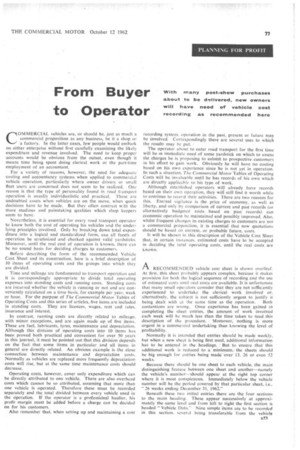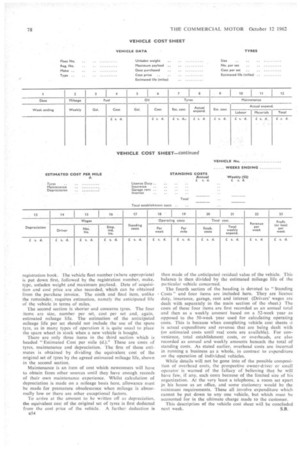From Buyer to Operator
Page 79

Page 80

If you've noticed an error in this article please click here to report it so we can fix it.
COMMERCIAL vehicles are, or should be, just as much a commercial proposition as any business, be it a shop or a factory. In the latter cases, few people would embark on either enterprise without first carefully examining the likely expenditure and revenue involved. The need to keep proper accounts would be obvious from the outset, even though it means time being spent doing clerical work or the part-time employment of an accountant.
For a variety of reasons, however, the need for adequate costing and accountancy systems when applied to commercial vehicle operation, particularly where owner drivers or small fleet users are concerned does not seem to be realized. One reason is that the type of personality found in road transport operation is usually individualistic and practical. These are undoubted assets when vehicles are on the move, when quick decisions have to be made. But they often contrast w:th the more studious and painstaking qualities which shop keepers seem to have.
Nevertheless, it is essential for every road transport operator to know both the cost of operating his vehicles and the underlying principles involved. Only by breaking down total expenditure into a logical and standardized form, can all facets of operation be scrutinized and checked against valid yardsticks. Moreover, until the real cost of operation is known, there can be no sound basis for deciding charges to customers.
Before describing the form of the recommended Vehicle Cost Sheet and its construction, here is a brief description of 10 items of operating costs and the groups into which they are divided.
Time and mileage are fundamental to transport operation and it is correspondingly appropriate to divide total operating expenses into standing costs and running costs. Standing costs are incurred whether the vehicle is running or not and are conveniently calculated on a time basis, for example per year. week or hour. For the purpose of The Commercial Motor Tables of Operating Costs and this series of articles, five items are included in standing costs. They are licences, wages, rent and rates. insurance and interest.
In contrast, running costs are directly related to mileage. with minor exceptions, and are again made up of five items. These are fuel, lubricants, tyres, maintenance and depreciation. Although this division of operating costs into 10 items has been proved both practical and convenient for over 50 years in this journal, it must be pointed out that this division depends on the fact that some items in particular and all items in general are directly related. An obvious example is the close connection between maintenance and depreciation costs. Normally as vehicles are replaced more frequently depreciation costs will rise, but at the same time maintenance costs should decrease, Operating costs, however, cover only expenditure which can be directly attributed to one vehicle. There are also overhead costs which cannot be so attributed, assuming that more than one vehicle is operated. Therefore these must be recorded separately and the total divided between every vehicle used in the operation. If the operator is a professidnal haulier. his profit margin must be added before a charge can be decided on for his customers. . .
Also remember that, when setting up and maintaining a cost recording system. operation in the past, present or future may be involved. Correspondingly there are several uses to which the results may be put.
The operator about to enter road transport for the first time will be in immediate need of some yardstick on which to assess the charges he is proposing to submit to prospective customers in his effort to gain work. Obviously he will have no costing based on his own experience since he is not yet in operation. in such a situation, The Commercial Motor Tables of Operating Costs will be invaluable until he has records of his own which are directly applicable to his type of work.
'Although established operators wifl already have records based on their own operation, they will still find it worth while to continue to record their activities. There are two reasons for this. Eternal vigilance is the price of economy, as well as liberty, and only by comparison of current and past records (or alternatively budgeted costs based on past records) can economic operation he maintained and possibly improved. Also, whilst frequent changes in existing charges to customers are not a commercial proposition, it is essential that new quotations should be based on current, or probable future, costs.
It will be shown in this description of the Vehicle Cost Sheet that, in certain instances, estimated costs have to be accepted in deciding the total operating costs, until the real costs are known.
RECOMMENDED vehicle cost sheet is shown overleaf. At first. this sheet probably appears complex, because it makes provision for both the logical sequence of recording and the use of estimated costs until real costs are available. It is unfortunate that many small operators consider that they are not suffic:entiy experienced to undertake the clerical work involved or. alternatively, the subject is not sufficiently urgent to justify it being dealt with at the same time. as the operation. Both contentions are wrong. Once experience has been gained in completing the sheet entries, the amount of work involved each week will be much less than the time taken to read this description of the procedure. Moreover, nothing is more urgent in a commercial undertaking than knowing the level of profitability.
Normally it is intended that entries should be made weekly, but when a new sheet is being first used, additional information has to be entered in the headings: But to ensure that this additional work is reduced to a minimum. the sheets • should be big enough for entries being made over 13, 26 or even 52 weeks.
Because there should be one sheet to each vehicle, the main distinguishing feature between one sheet and another—namely the vehicle's number--should appear at the right top corner where it is most conspicuous. Immediately below the vehicle number will be the period covered by that particular sheet, i.e.. "26 weeks ending December 31, 1962."
Beneath these two initial entries there are the four sections to the main heading. These appear successively at approximately the same level and from left to right the first section is headed "Vehicle Data." Nine simple items are to be recorded in this section. several being transferable from the vehicle
registration book. The vehicle fleet number (where appropriate) is put down first, followed by the registration number, make, type, unladen weight and maximum payload. Date of acquisition and cost price are also recorded, which can be obtained from the purchase invoice. The ninth and final item, unlike the remainder, requires estimation, namely the anticipated life of the vehicle in terms of miles.
The second section is shorter and concerns tyres. The four items are size, number per set, cost per set and, again, estimated mileage life. The estimation of the anticipated mileage life per set should not include the use of the spare tyre, as in many types of operation it is quite usual to place the spare wheel in stock when a new vehicle is bought.
There are only three items in the third section which is headed "Estimated Cost per mile (d.)." These are costs of tyres, maintenance and depreciation. The first of these estimates is obtained by dividing the equivalent cost of the original set of tyres by the agreed estimated mileage life, shown in the second section.
Maintenance is an item of cost which newcomers will have to obtain from other sources until they have enough records of their own maintenance experience. Whilst calculation of depreciation is made on a mileage basis here, allowance must be made for premature obsolescence when mileage is abnormally low or there are other exceptional factors.
To arrive at the amount to be written off as depreciation, the equivalent cost of the original set of tyres is first deducted from the cost price of the vehicle. A further deduction is
then made of the anticipated residual value of the vehicle. This balance is then divided by the estimated mileage life of the particular vehicle concerned, The fourth section of the heading is devoted to "Standing Costs" and four items are included here. They are licence duty, insurance, garage, rent and interest (Drivers' wages are dealt with separately in the main section of the sheet.) The costs of these four items are first recorded as an annual total and then as a weekly amount based on a 52-week year as opposed to the 50-week year used for calculating operating costs. This is because when completing vehicle cost sheets it is actual expenditure and revenue that are being dealt with (or estimated costs until real costs are available). For convenience, total establishment costs, or overheads, are also recorded as annual and weekly amounts beneath the total of standing costs. As stated earlier, overhead costs are incurred in running a business as a whole, in contrast to expenditure on the operation of individual vehicles.
While details will not be gone into of the possible composition of overhead costs, the prospective owner-driver or small operator is warned of the fallacy of believing that he will have few, if any, such costs because of the limited size of his organization. At the very least a telephone, a room set apart in his house as an office, and some stationery would be the minimum requirements. These all involve expenditure which cannot be put down to any one vehicle, but which must be accounted for in the ultimate charge made to the customer.
This description of the vehicle cost sheet will be concluded next week. S.R.




















































































































